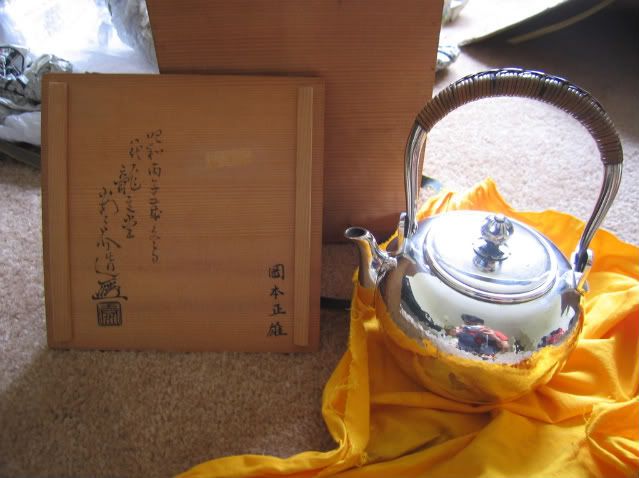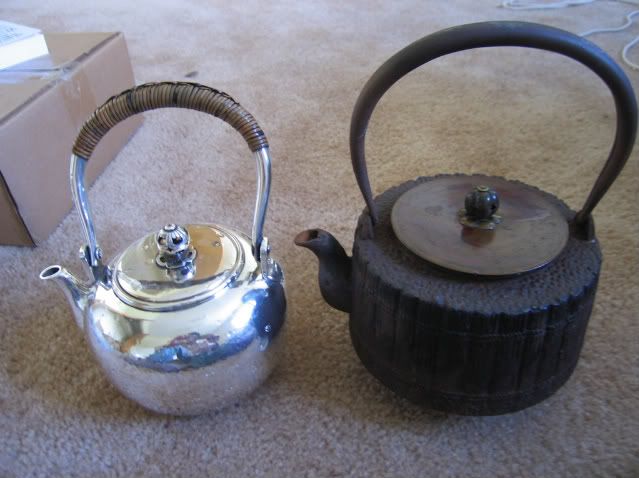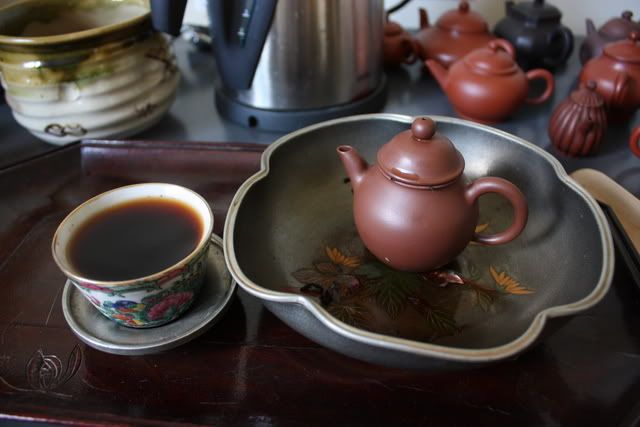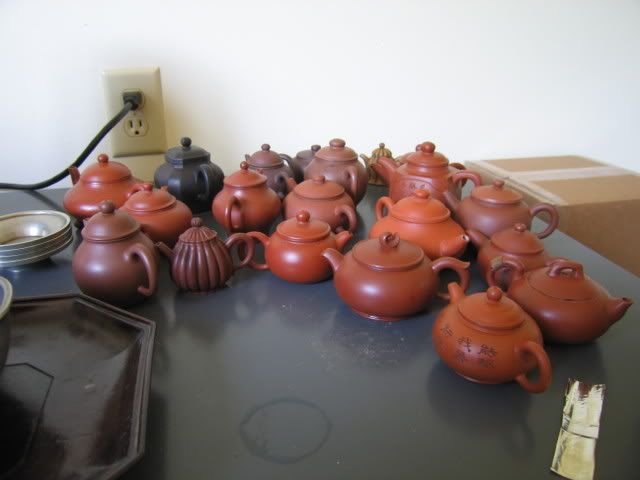
This thing just came in the mail. No, it’s not mine (I wish!). But I do get the privilege of playing with it and using it for a little bit before handing it off to the friend whom I helped source this item. You can see my reflection in the kettle :).
Since there’s very little literature out there on these things, I figured I should tell you all what I have learned so far. Silver kettles come in different shapes and sizes. The small ones are very thin and were more like teapots than kettles — they often have an internal filter, and have an engraved surface with a flower or some other motif. Those are the cheapest and really not meant for water boiling. Then you have the medium sized ones like this one, which are good enough sized for brewing purposes. Compare:

And my tetsubin is fairly large. To give you a better idea, from the tip of the spout to the other end, it’s about 6 inches or about 15.5cm. The seller said this weighs 570g including everything. Then you have the large ones — the largest ones I’ve seen are around 1100g in weight and correspondingly larger in size. It’s pretty heavy, and a lot of silver. Obviously, you have to pay more for those, but even those ones should be obtainable for under $1600 or so unless it’s extremely intricately decorated or special in some other way (famous person, etc..).
A really important thing with all Japanese wares that are of some age though is the box — as you can see in the first picture, the box has stuff written on it. Here, it had a date — winter 1936 (written as Showa “bingzi” using the old Chinese 60 years cycle system). That’s more than 70 years ago. The thing also says “8th generation Ryubundo”, and then a name, “made by”, and then a Japanese style signature and a seal. The name is probably that of the person who is the person holding the firm “Ryubundo”, a fairly famous metalworks maker (best known among aficiandos for their tetsubins probably). So, this is probably made by that guy — not a bad pedigree. The name on the bottom right was probably the owner of the kettle. Sometimes boxes also come with some insert — a printed name card or piece of paper that basically advertise the shop’s wares, but the important info is always what’s on the box itself, usually the lid and sometimes the bottom of the box. But wait — look at the exterior of the lid, and it says “Precious Pearl shaped Tetsubin”. Hmmm, tetsubin?
The box (and the yellow cloth) are both part of the packaging, and having the original (rather than just any random box for something else) can significantly change the value of the item — usually for the higher. Unfortunately, this kettle didn’t come with the original box, but for less than 3x the price of the silver it took to make the kettle at today’s crazy prices, one can hardly complain. This actually happens a lot, as I’ve bought a bowl or some other stuff that obviously didn’t have the original box but instead came in what fit. Still, having A box is handy — not least because it offers quite a bit of protection.
Then there are the details — like whether or not something is “pure silver”. From what I understand, the “jungin” stamp on silver items worked sort of like “sterling silver” stamps on western silver items — it’s not quite “pure”, but pure enough. And…. if something doesn’t have it, chances are it’s not actually “pure silver” — if you made the item with high purity silver, you’d want the people buying it to know. To do otherwise would be, well, stupid. Silver alloys are not bad, but with lower purity — it should command a lower price. The Japanese “jungin” seal is a tiny little thing, usually in the center of the kettle’s bottom — 4mm by 2mm, very small.
I think those are all the things to really look out for in a silver kettle. The rest are intuitive — is it well made? How was it made? This one you can see little hammer marks on it — a deliberate design decision. Some have hobnails. Others are more unique — swirls, etc. Once I saw one that was absolutely gorgeous, with a jade ball as a handle for the lid, and a very unique design. I still wonder why I didn’t jump on that thing.
How does it work for tea though?
I gave it a try today, although I don’t want to be too conclusive without more tries with it. Drinking the same tea as I did the last two days, I think I can say the tea came out a little more contemplative — there’s definitely an extra dimention in the tea that I haven’t tasted before, and that it gave the tea a very deep throatiness that lasted quite a long time. That itself was rather impressive. I am going to play with it tomorrow with another tea — a lighter fare, perhaps, to see how it goes.






 RSS - Posts
RSS - Posts
Interesting.... would 250C in my oven work?